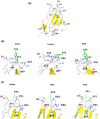A new catalytic site functioning in antigen cleavage by H34 catalytic antibody light chain
- PMID: 36357546
- PMCID: PMC9649737
- DOI: 10.1038/s41598-022-23689-6
A new catalytic site functioning in antigen cleavage by H34 catalytic antibody light chain
Abstract
The cleavage reactions of catalytic antibodies are mediated by a serine protease mechanism involving a catalytic triad composed of His, Ser, and Asp residues, which reside in the variable region. Recently, we discovered a catalytic antibody, H34 wild type (H34wt), that is capable of enzymatically cleaving an immune-check point PD-1 peptide and recombinant PD-1; however, H34wt does not contain His residues in the variable region. To clarify the reason behind the catalytic features of H34wt and the amino acid residues involved in the catalytic reaction, we performed site-directed mutagenesis focusing on the amino acid residues involved in the cleavage reaction, followed by catalytic activity tests, immunological reactivity evaluation, and molecular modeling. The results revealed that the cleavage reaction by H34wt proceeds through the action of a new catalytic site composed of Arg, Thr, and Gln. This new scheme differs from that of the serine protease mechanism of catalytic antibodies.
© 2022. The Author(s).
Conflict of interest statement
The authors declare no competing interests.
Figures











Similar articles
-
Innate antibody catalysis.Mol Immunol. 1999 Dec;36(18):1215-22. doi: 10.1016/s0161-5890(99)00141-8. Mol Immunol. 1999. PMID: 10684961
-
Design of a serine protease-like catalytic triad on an antibody light chain displayed on the yeast cell surface.Appl Microbiol Biotechnol. 2007 Dec;77(3):597-603. doi: 10.1007/s00253-007-1197-0. Epub 2007 Sep 27. Appl Microbiol Biotechnol. 2007. PMID: 17899065
-
Catalytic antibody light chain capable of cleaving a chemokine receptor CCR-5 peptide with a high reaction rate constant.Biotechnol Bioeng. 2004 Apr 20;86(2):217-25. doi: 10.1002/bit.20031. Biotechnol Bioeng. 2004. PMID: 15052642
-
Nucleophilic proteolytic antibodies.Appl Biochem Biotechnol. 2000 Jan-Mar;83(1-3):221-31; discussion 231-2, 297-313. doi: 10.1385/abab:83:1-3:221. Appl Biochem Biotechnol. 2000. PMID: 10826962 Review.
-
Catalytic triads and their relatives.Trends Biochem Sci. 1998 Sep;23(9):347-52. doi: 10.1016/s0968-0004(98)01254-7. Trends Biochem Sci. 1998. PMID: 9787641 Review.
Cited by
-
Direct conversion of a general antibody to its catalytic antibody and corresponding applications -Importance and role of Pro95 in CDR-3.Proc Jpn Acad Ser B Phys Biol Sci. 2023;99(6):155-172. doi: 10.2183/pjab.99.010. Proc Jpn Acad Ser B Phys Biol Sci. 2023. PMID: 37331814 Free PMC article. Review.
-
Structural and biochemical differences between non-catalytic and catalytic antibodies.MAbs. 2025 Dec;17(1):2503978. doi: 10.1080/19420862.2025.2503978. Epub 2025 May 12. MAbs. 2025. PMID: 40356286 Free PMC article.
-
Enzymatization of mouse monoclonal antibodies to the corresponding catalytic antibodies.Sci Rep. 2024 May 28;14(1):12184. doi: 10.1038/s41598-024-63116-6. Sci Rep. 2024. PMID: 38806597 Free PMC article.
References
-
- Paul S, et al. Catalytic hydrolysis of vasoactive intestinal peptide by human autoantibody. Science. 1989;244:1158–1162. - PubMed
-
- Hifumi E, Kondo H, Mitsuda Y, Uda T. Catalytic features of monoclonal antibody i41SL1-2 subunits. Biotechnol. Bioeng. 2003;84:485–493. - PubMed
-
- Mei S, Mody B, Eklund SH, Paul S. Vasoactive intestinal peptide hydrolysis by antibody light chains (Communication) J. Biol. Chem. 1991;266:15571–15574. - PubMed
-
- Gao QS, et al. Molecular cloning of a proteolytic antibody light chain. J. Biol. Chem. 1994;269:32389–32393. - PubMed
-
- Taguchi H, et al. Autoantibody-catalyzed hydrolysis of Amyloid β peptide. J. Biol. Chem. 2008;283:4714–4722. - PubMed
Publication types
MeSH terms
Substances
LinkOut - more resources
Full Text Sources

